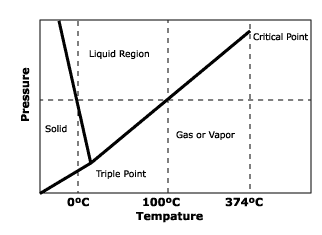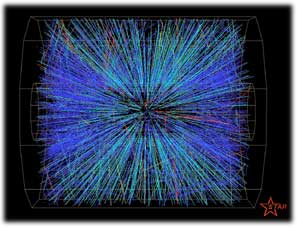
|
Phases of Nuclear Matter

As we know, water (H2O) can exist as ice, liquid, or steam. At atmospheric pressure and below the 0ºC freezing point of water we have ice. Between 0ºC and 100ºC, water is a liquid. Above the boiling point of 100ºC, water becomes the gas that we call steam. We also know that we can raise the temperature of water by heating it, that is to say adding energy to it.
However, when water reaches its melting or boiling points, additional heating does not immediately lead to a rise in temperature. Instead, we have to overcome the latent heats of fusion (80 kcal/kg, at the melting point) or vaporization (540 kcal/kg, at the boiling point). During the boiling process, as we add more heat, more of the liquid water turns into steam. Even though heat is being added, the temperature stays at 100ºC. As long as there is still liquid water left, the gas and liquid phase are in coexistence. The temperature cannot rise until all of the liquid is converted to steam. This type of transition between two phases with a latent heat and phase coexistence is called a "first order phase transition."
As we raise the pressure, the boiling temperature of water increases until the critical point at a pressure of 22.1 Mpa (218 times atmospheric pressure) and a temperature of 374ºC is reached. There, the phase coexistence stops, and the phase transition becomes continuous or "second order." We can make a diagram, which shows the states of H2O depending on pressure and temperature.

This diagram indicates that as the pressure increases, ice can turn into water. The diagram can be used to predict the state of H2O at any temperature and pressure. We call the mathematical relations inferred by the chart the "equation of state" of water.
Just as the state of a collection of atoms or molecules depends on temperature and pressure, we find that the state of a nucleus depends on temperature and on the density of the nucleons. Thus we may ask what is the equation of state for nuclear matter? In their normal states of lowest energy, nuclei show liquid-like characteristics and have a density of 0.17 nucleons/fm3. In more conventional units, this corresponds to 2.7x1017 kg/m3, or 270 trillion times the density of liquid water.
In a laboratory, the only possible way to heat nuclei to significant temperatures is by colliding them with other nuclei. The temperatures reached during these collisions are astounding. In atomic physics, the electron-volt (1.6x10-19 joules) is used as a convenient unit because it is roughly the energy scale of atomic and chemical processes. Similarly, nuclear scientists use millions of electron-volts or MeV (1.6x10-13 joules) as a convenient energy unit because it is roughly the energy scale of nuclear processes. An average energy of 1 MeV corresponds to a temperature of 1.2x1010 K. The temperatures we can reach in nuclear collisions range up to 100 MeV and above–more than 200 million times the temperature at the surface of the Sun (~5,500 K)!
As we heat nuclei to a temperature of a few MeV, some of the nuclear "liquid" evaporates. From knowing the general form of the interactions between nucleons, we know that, just like water, the nuclear liquid also has a latent heat of vaporization, and nuclei should undergo a first-order phase transition. This liquid-gas coexistence is also expected to terminate at a critical point, the critical point of nuclear matter. One of the major thrusts of heavy ion research at laboratories such as Michigan State University’s National Superconducting Cyclotron Laboratory is to find out if these theoretical expectations are correct. Experiments try to determine at what temperature and density the critical point of nuclear matter is located.
There are major challenges that nuclear physicists face in their efforts to explore the nuclear equation of state and these nuclear phase transitions. We can only establish the hot and dense conditions needed for this process during heavy ion collisions. Thus we do not have the luxury to carefully prepare our sample at a given pressure, temperature and density, as is done when studying the phase diagram of water. Instead we have only a time interval of about 10-21 seconds during which to conduct our experiment. To complicate things even more, our sample does not stay at a given density and temperature, but expands and cools during our experiment. We also do not have any direct way of measuring the state variables (temperature, pressure, density). We need to determine them from observables such as:
- the abundance of isotopes,
- the population of excited nuclear states,
- the shapes of the energy spectra from nuclear collision remnants
- the production of particles such as pions.
It is also not obvious that thermal equilibrium can be established during these short time scales. Finally, there is the problem of finite particle number. When studying the phases of water, the sample usually contains very large numbers of molecules. This, again, is a luxury not at our disposal during heavy ion collisions, where the number of nucleons is at best only a few hundred. We then have to figure out what signatures of a phase transition remain when there are only so few elementary constituents present.
Despite these challenges, progress in this field has been significant. We now have deep insight as how to measure the thermodynamics state variables during heavy ion collisions. We are confident that thermal equilibrium can be established, have found evidence for phase coexistence, and are beginning to pin down the critical point of the nuclear liquid-vapor phase diagram. Information about the size of fragments produced when nuclear matter is near its critical point gives essential information on the nuclear equation of state. Recent experiments on nuclear breakup are leading to improved understanding of this important question.

The phase diagram for nuclear matter, as predicted theoretically. The horizontal axis shows the matter density, and the vertical axis shows the temperature. Both axes are shown in logarithmic scale, and the density is given in multiples of normal nuclear matter density. The temperature axis is reversed from the phase diagram of water.
The figure shows that the phase transition between the nuclear liquid and a gas of nucleons is not the only phase transition that heavy ion scientists are studying. At even higher temperatures and densities, nucleons themselves can undergo a phase transition.
We can view each nucleon as a "bag" containing quarks and gluons. These quarks and gluons can move relatively freely inside their own bag, but "bag" theory says that they cannot escape from the bag–they are "confined." For this reason, we have never been able to detect individual free quarks or gluons. However, if we are able to produce an extremely dense gas of hadrons (mainly pions and nucleons), then their bags can overlap. This overlap lets the quarks and gluons from different bags to mix freely and travel across the entire nuclear volume. We call this state a "quark-gluon plasma," in analogy with an atomic plasma in which electrons become unbound from atoms. From theoretical calculations, we also expect the phase transition to a quark-gluon plasma to be of first order, with a phase coexistence region. Major research efforts at BNL (Brookhaven National Laboratory) in New York and at CERN (Conseil Europeen pour la Recherche Nucleaire) in Switzerland are directed toward establishing the conditions for creating this phase transition and observing its signatures. The Relativistic Heavy Ion Collider (RHIC), which has been constructed BNL, has as its main mission the study of this exotic and unique phase transition in the nuclear equation of state. It will produce two counter-circulating beams of gold nuclei, each at speeds extremely close to the speed of light, and collide them.

This is a similar phase diagram to the phase diagram for nuclear matter. A representation of the quarks is shown in the hadron gas area. The mixed phased region shows the existence of both hadrons and quarks and gluons. The quark-gluon plasma region shows the existence of quarks and gluons.
All of the theoretical and experimental challenges listed above are also present when studying the transition to the quark-gluon plasma. In addition, there is another, possibly even more severe obstacle to overcome: the quark-gluon plasma cannot survive longer than a few times 10-22 seconds. After that, the density and temperature reached during a heavy ion collision fall to values that force quarks and gluons to recombine into hadrons again. The number of hadrons produced in relativistic heavy ion collisions is staggering. For every nucleon that was initially contained in the two gold nuclei, we can expect between 10 and 50 pions to be produced during each RHIC collision. This amounts to many thousands of hadrons emerging from each relativistic heavy ion collision, as shown below. The essential problem for the nuclear scientist is then to distinguish between those hadrons that were created from the ashes of the quark-gluon plasma and those that were created in the dense hadron gas.
The figure below shows a simulation of a single collision in one of the new detectors (STAR). Each line represents a particle that is tracked and measured in the magnetic field of the detector. The detector measures the thousands of particles produced by the collision. Analysis of the data is like an attempt to "put Humpty-Dumpty together again"–to see if the collision showed any evidence that a quark-gluon plasma had been formed.

Collision between two gold nuclei in the STAR detector at the RHIC accelerator. Each line represents the path of a particle produced in the collision.
What is the purpose of studying the nuclear matter phase diagram? The answer is that we need this information to understand the early history of our universe, and to understand high-density objects, called "neutron stars" in our present-day universe.
A region, which is labeled the Big Bang, is in the upper left corner of Figs. 9-2 and 9-3 is a region labeled the Big Bang. In the first microsecond after the Big Bang, the entire universe should have been in this state. At that time, the universe would have fit inside the present orbit of the planet Jupiter. Heavy ion collisions at both RHIC and CERN’s Large Hadron Collider (LHC) will also create dense matter and antimatter in about equal quantities. These accelerators will produce conditions similar to that found in our early universe.
Figures 9-2 and 9-3 also show a region labeled neutron star. When a massive star undergoes a supernova explosion, a core of iron nuclei remains. Gravity brings the nuclei together. The short-range nuclear repulsive force is not strong enough to keep the nuclei apart. As the core collapses, the individual nucleons separate from the nucleus. The protons become neutrons by inverse beta decay. Therefore, the neutron star is very large collection of neutrons, typically a few kilometers in diameter, which is held together by gravity. Some theorists predict that a neutron star of a large enough mass could be of high enough density to produce a quark-gluon plasma. This is indicated by the high-density end of the neutron star region.
Thus, the study of the nuclear equation of state is connected to the initial phases of the early Universe, to ultra-violent stellar explosions, and to experiments at laboratories around the world. These laboratories bring nuclei, which are traveling almost at the speed of light, into violent collisions to perhaps produce a state of matter in which quarks and gluons, if only briefly, become free particles. As the RHIC facility became operational in 1999 and later the LHC facility comes into operation, we can expect exciting new results. These accelerators have produced states of matter in the laboratory that have not existed since the first microsecond of the Big Bang.
|
|

